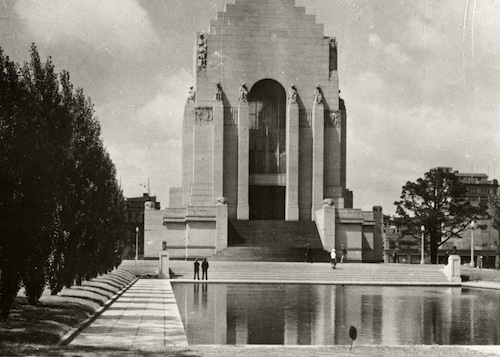By RAHS Volunteer Elizabeth Heffernan

Anzac Memorial Hyde Park, Sydney 1940 [RAHS Photograph Collection]
On 24 November 1934, sixteen years after the signing of the Armistice on 11 November 1918, the Anzac Memorial in Sydney’s Hyde Park first opened its doors. An estimated one-hundred-thousand spectators attended the ceremony. Eighty-five years later it remains an iconic national monument, commemorating the “ENDURANCE, COURAGE AND SACRIFICE” of Australia’s fallen soldiers in the First World War. [1]
For all its timeless splendour, however, the road to the Memorial’s opening was not an easy one. Interest in the construction of a war memorial in Sydney was sparked as early as 1916 but it was not until 1923, with the passage of the Anzac Memorial (Building) Act, that real plans began to be made. It would take another decade for the completed building to be unveiled. The delays stemmed from a number of reasons: financial restraints, debate over design, and indecision over location. In 1929, to resolve the indecision, the Anzac Memorial Trustees announced a design competition, of which the winner would receive two-hundred and fifty pounds and the title of architect for the new Anzac Memorial. [2]
Australian architect Bruce Dellit’s Art Deco design was victorious. It was simple yet evocative, current yet laden with historical and cultural symbolism. In collaboration with English sculptor Rayner Hoff, Dellit set about bringing his vision of the Memorial to a reality. However, the pair encountered some difficulty. When the monument opened in 1934, though spectacular, it lacked a few key elements of Dellit’s design. The Trustees also vetoed several of Hoff’s proposed statues. Some of these design changes were remedied in time for the centenary of the Armistice in 2018. [3]
The Anzac Memorial we see today is as close to Dellit’s original vision as possible. Though an imposing structure, it remains a space of private mourning and reflection. The sweeping stairs into the Hall of Memory invite the visitor to gaze up into the Dome of Stars or down into the Well of Contemplation and upon Hoff’s confronting brass sculpture, Sacrifice. An inscription set at the western entrance to the Hall of Silence implores visitors to “Let Silent Contemplation be Your Offering” – an apt request for the remembrance of those whose own voices have been silenced for more than a hundred years. [4]
References:
[1] Bruce Dellit, quoted in “The History of the Anzac Memorial”, Anzac Memorial, Hyde Park, Sydney, <https://www.anzacmemorial.nsw.gov.au/our-stories/history-anzac-memorial>, accessed 5 November 2019.
[2] “The History of the Anzac Memorial”; Laila Ellmoos, “Anzac War Memorial Hyde Park”, Dictionary of Sydney, 2008, <https://dictionaryofsydney.org/entry/anzac_war_memorial_hyde_park>, accessed 5 November 2019.
[3] “The History of the Anzac Memorial”; Tim Barlass, “Anzac Memorial completed after 84 years, ready for armistice centenary”, Sydney Morning Herald, 6 October 2019, <https://www.smh.com.au/national/anzac-memorial-completed-after-84-years-ready-for-armistice-centenary-20181005-p50805>, accessed 5 November 2019.
[4] Ellmoos, “Anzac War Memorial Hyde Park”.

0 Comments